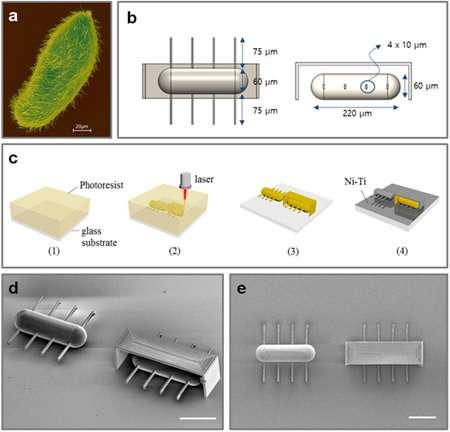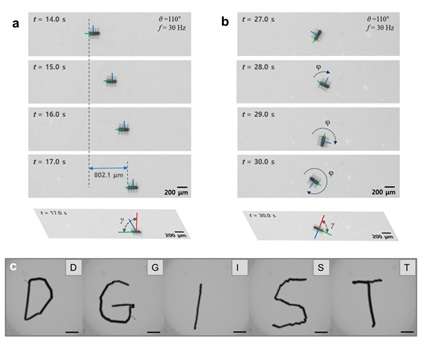Research team develops world's first ciliary stroke motion microrobots

A research team at Daegu Gyeongbuk Institute of Science and Technology (DGIST), South Korea, developed ciliary microrobots for chemical and cell delivery that can be precisely controlled and that move via paramecium-like ciliary motion.
DGIST announced on Tuesday August 2, 2016 that Professor Choi Hong-soo's research team from the Department of Robotics Engineering developed ciliary microrobots with high propulsion efficiency in highly-viscous fluid environments in the human body such as blood by mimicking the movement of paramecia's cilia.
Professor Choi's research team succeeded in fabricating the world's first ciliary microrobots utilizing ultra-fine three-dimensional processing technology and asymmetric magnetic drive technology by applying microorganism's ciliary movement, which thus far had only been theorized but never put into practice.
Microfluidic environments in which microorganisms move include highly viscous environments like the human body's internal fluids; thus, in a macro environment, it is difficult to create propulsion with swimming-based mechanisms such as inertia-based symmetrical rowing like that used by large animals such as humans. As such, microorganisms moving in highly-viscous environments utilize various other propulsion techniques such as spiral drive motion, progressive wave motion, ciliary asymmetric reciprocating motion, and the like.
Microrobots that use propulsion mechanisms such as spiral drive motion and progressive wave motion were first realized and implemented at the Zurich Federal Institute of Technology, Switzerland; University of Twente, Netherlands; and Harvard University, USA. However, the development of microrobots that move utilizing ciliary motion has thus far been absent due to the difficulty of producing a microstructure with a large number of cilia as well as with asymmetrical drive.

Professor Choi's research team has produced a ciliary microrobot with nickel and titanium coating on top of photo-curable polymer material, using three-dimensional laser process technology and precise metal coating techniques.
In addition, the team verified that the speed and propulsion efficiency of their newly-developed microrobots were much higher than those of existing conventional microrobots moving under magnetic attraction drive after measuring the ciliary microrobots' movement utilizing asymmetrical magnetic actuation technology.
The maximum speed of ciliary microrobots with a length of 220 micrometers and a height of 60 micrometers is 340 micrometers per second, thus they can move at least 8.6 times faster and as much as 25.8 times faster than conventional microrobots moving under magnetic attraction drive.
In comparison to previously developed microrobots, Professor Choi's ciliary microrobots are expected to deliver higher amounts of chemicals and cells to target areas in the highly viscous body environment thanks to their ability to freely change direction and to move in an 80 micrometer-diameter sphere to the target point shown in the experiment using the magnetic field.
Professor Choi from DGIST's Department of Robotics Engineering said, "With precise three-dimensional fabrication techniques and magnetic control technology, my team has developed microrobots mimicking cilia's asymmetric reciprocation movement, which has been never realized so far. We'll continually strive to study and experiment on microrobots that can efficiently move and operate in the human body, so that they can be utilized in chemical and cell delivery as well as in non-invasive surgery."
More information: Sangwon Kim et al. Fabrication and Manipulation of Ciliary Microrobots with Non-reciprocal Magnetic Actuation, Scientific Reports (2016). DOI: 10.1038/srep30713
Journal information: Scientific Reports
Provided by DGIST





















